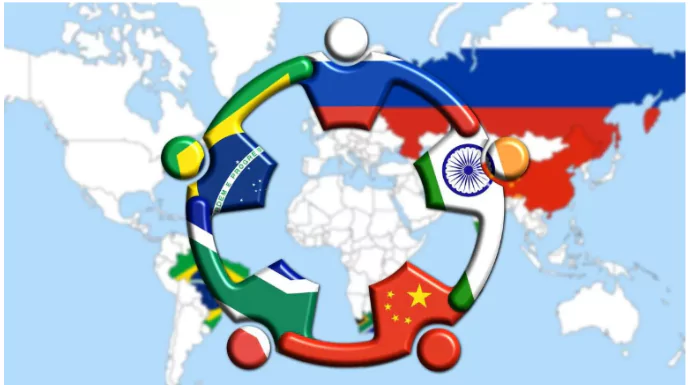| Area |
Initiatives |
| Financial |
- New Development Bank (NDB): Entering its “second golden decade,” NDB focuses on local currency financing, reducing inequality, and sustainable development.
- Contingent Reserve Arrangement (CRA): Revised to include more eligible currencies, improve risk management, and enable new members.
- BRICS Cross-Border Payments Initiative: Aims for fast, affordable, and secure payment systems through interoperable technology.
- BRICS Multilateral Guarantees (BMG): A pilot mechanism under NDB to de-risk investments without needing new capital.
- New Investment Platform (NIP): Under discussion to deepen economic cooperation.
|
| Voice to Global South |
- Support for UN Reform: Called for expanded representation of Africa, Asia, and Latin America in the UNSC.
- Supported UNGA Resolution 79/272 on the 80th anniversary of WWII
- Backed India & Brazil: Advocated for greater roles in global governance.
- BRICS Plus & Partner Countries: Welcomed new partner nations and expanded dialogues.
- Support for African Union (AU) in G20: Endorsed full AU membership in G20 and enhanced representation in multilateral forums.
- Consider new ways to support AU peace support operations, mediation efforts, peace processes and broader peacebuilding initiatives in the African continent.
|
| Security & Conflict Resolution |
- Counterterrorism: Condemned terrorism in J&K and Russia; supported finalization of Comprehensive Convention on International Terrorism (CCIT).
- Conflict Mediation: Supported diplomatic resolutions in Ukraine, Middle East, Sudan, Syria, and Haiti.
- Peacekeeping & Humanitarian Law: Endorsed inclusive peace processes, UN-AU mediation, and condemned humanitarian violations.
- Nuclear Disarmament & Outer Space: Backed nuclear-weapon-free zones and prevention of space weaponization.
- Reaffirmed full commitment to UNSC Resolution 1325 (2000): Addresses the impact of war on women and the importance of women’s full and equal participation in conflict resolution, peacebuilding, peacekeeping, humanitarian response and in post-conflict reconstruction.
|
| Science & Technology |
- PartNIR & Industry 4.0: Structured collaboration in intelligent manufacturing, digital transformation, and SME tech adoption.
- BRICS STI Cooperation (2015–2025): Joint research on AI, quantum, and industrial innovation.
- Submarine Cable Proposal: Feasibility study for a high-speed BRICS internet cable.
- Remote Sensing & Space Council: Agreed to set up BRICS Space Council and enhance joint space-based monitoring.
|
| Health & Pandemic Preparedness |
- WHO Pandemic Agreement: Supported a global pandemic preparedness pact.
- BRICS Vaccine R&D Center: Promoted equitable access to healthcare, diagnostics, and medicines.
- Social Diseases Partnership: Adopted action against socially determined diseases.
- Digital Health & AI: Boosted cooperation on digital health and responsible AI in healthcare.
- BRICS TB Research Network: Deepened collaboration on tuberculosis research.
- UHC & Medical Regulation: Focused on universal health coverage and regulatory convergence.
|
| Climate & Environment |
- COP30 & Climate Finance: Strong support for COP30 in Brazil; adopted Leaders’ Framework on Climate Finance.
- Energy Transition: Reaffirmed commitment to SDG 7, clean energy, and non-discriminatory access to tech.
- Carbon Markets: Adopted BRICS Carbon Markets Partnership and accounting principles.
- Tropical Forest Facility: Supported launch of forest sustainability mechanism at COP30.
- Plastic Pollution: Called for a legally binding global treaty based on UNEA resolution 5/14.
- Critical Minerals: Pushed for fair supply chains and resource sovereignty.
|
| Digital & Cyber Cooperation |
- BRICS Digital Public Infrastructure (DPI): Promoted inclusive, interoperable DPIs respecting national sovereignty.
- Cybersecurity: BRICS CERT cooperation, cybercrime treaty (UN 2025), and Rapid Information Security Channel.
- AI Governance: Adopted Global AI Governance Statement; supported capacity-building.
- Data Sovereignty: Welcomed BRICS Data Economy Governance Understanding.
- UN Cybercrime Convention: Called for early ratification and a supplementary protocol.
|
| Agriculture & Food Security |
- BRICS Grain Exchange: Backed grain trading platform to ensure fair pricing and emergency supply.
- Deccan Principles: Endorsed inclusive agri-value chains and local agri-tech.
- Food Loss Reduction: Emphasized digital tools, plant and animal health, and e-certification systems.
- Wider Agri-Cooperation: Promoted fisheries, aquaculture, and local machinery production.
|
| Trade & MSME Support |
- Inclusive Trade Framework: Adopted BRICS Trade and Sustainable Development Framework.
- Support for MSMEs: Promoted digital tools, sustainable supply chains, and national SDG-aligned growth.
- Ethical Diamond Trade: Reaffirmed support to the Kimberley Process and sustainable precious metal markets.
- Sustainable Government Procurement: Emphasized inclusive growth and industrial policy.
|
| Human Rights & Inclusion |
- Women’s Empowerment: Advocated equal access to education, leadership, and STEM; tackled online misogyny.
- Racial Justice & Reparations: Supported African Union’s reparations theme; reaffirmed anti-racism commitments.
- Beijing Declaration (30 years): Committed to digital rights, anti-discrimination, and workplace safety policies.
- Inclusive Labor & AI Transitions: Focused on social protections, skills, and AI’s impact on jobs.
|
| Education, Culture & Sports |
- Technical and Vocational Education and Training (TVET) Alliance Charter: Boosted technical and vocational education for sustainable inclusion.
- BRICS Network University: Celebrated 10 years; new members and quality standards.
- Creative Economy Platform: Supported innovation in cultural industries.
- MoU on Sports: Signed to promote local/traditional sports and policy dialogue.
|
| Urban Development & Youth |
- Youth MoU (2025): Strengthened school-to-work transitions and structured funding.
- Urbanization Forum: Pushed for affordable housing and SDG-localization.
- Young Scientists & Deep-Sea Research: Enhanced youth R&D and environmental research platforms.
|
| People-to-People Cooperation |
- Parliamentary & Civil Forums: Elevated cooperation through youth, legal, women’s and SME forums.
- Inter-Civilizational Dialogue: Marked International Day for Dialogue among Civilizations.
- Cultural Restitution: Advocated return of cultural property and heritage protection.
|
| Disaster Resilience & Governance |
- Working Plan (2025–28): Focused on inequality, early warning, and resilient infrastructure.
- Civil Society Dialogue: BRICS Civil Council submitted first report; enhanced Sherpa–civil interface.
- Membership Expansion: Reaffirmed inclusivity, sovereign equality, and documentation transparency.
|
![]() 7 Jul 2025
7 Jul 2025


